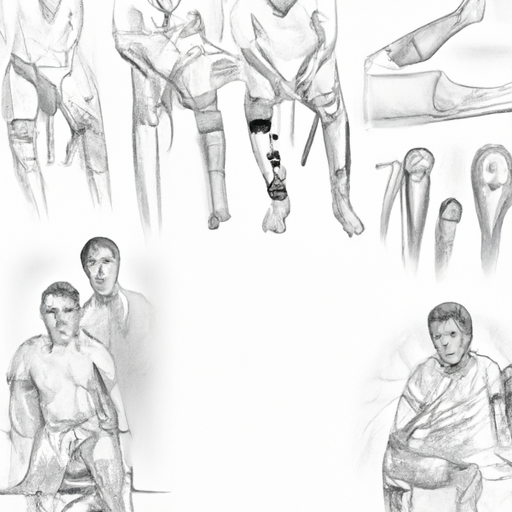Sports injuries can be a common occurrence for athletes of all levels, from recreational enthusiasts to professional competitors. These injuries can range from minor sprains and strains to more serious conditions such as concussions. Understanding the symptoms, causes, and prevention strategies for sports injuries is essential for athletes and medical professionals alike. In this article, we will delve into the world of sports injuries, exploring the common symptoms, causes, and prevention strategies. We will also discuss the essential steps for diagnosing and treating sports injuries, ensuring a swift recovery for athletes. Additionally, we will explore the wide range of sports injuries, from sprains to concussions, and examine the most effective treatment options available. Whether you are a sports enthusiast or a medical professional, this article will provide valuable insights into the world of sports injuries.
1. "Understanding Sports Injuries: Common Symptoms, Causes, and Prevention Strategies"
Sports injuries are a common occurrence among athletes of all levels, from amateurs to professionals. These injuries can range from minor sprains and strains to more serious fractures and tears. Understanding the symptoms, causes, and prevention strategies of sports injuries is crucial for athletes and sports enthusiasts to maintain their overall well-being and performance.
One of the most common symptoms of sports injuries is pain. Athletes may experience sharp or dull pain in the affected area, which can significantly limit their ability to perform. Swelling and inflammation are also typical symptoms, indicating an injury that requires medical attention. Additionally, bruising, stiffness, and a reduced range of motion are frequently observed in sports injuries.
Sports injuries can have various causes, with some being more prevalent than others. Overuse injuries occur when an athlete repeatedly performs the same motion or activity, resulting in damage to the muscles, tendons, or ligaments. These injuries often occur in sports that involve repetitive movements, such as running or tennis. On the other hand, acute injuries are usually the result of a sudden force or impact, such as a fall, collision, or twisting motion. These injuries can lead to fractures, sprains, strains, or dislocations.
Prevention strategies play a vital role in minimizing the risk of sports injuries. Proper warm-up exercises and stretching before engaging in physical activity help prepare the muscles, tendons, and ligaments for the demands of the sport. Adequate rest and recovery periods are also essential to prevent overuse injuries. Athletes should listen to their bodies and avoid pushing themselves too hard, as fatigue increases the likelihood of injuries. Wearing appropriate protective gear, such as helmets, pads, or braces, can provide an extra layer of safety during sports activities.
Furthermore, maintaining good overall physical fitness is crucial for injury prevention. Regular strength and conditioning exercises help build strong muscles and improve flexibility, reducing the risk of strains and sprains. Engaging in cross-training activities can also help balance the workload on different muscle groups and minimize the strain on specific areas of the body.
In conclusion, understanding
2. "Diagnosing and Treating Sports Injuries: Essential Steps for a Swift Recovery"
Diagnosing and treating sports injuries are crucial steps towards ensuring a swift recovery for athletes. Whether it’s a sprained ankle, a torn ligament, or a muscle strain, proper diagnosis and treatment are essential for athletes to get back in the game as quickly and safely as possible.
The first step in diagnosing a sports injury is a thorough physical examination by a qualified healthcare professional, such as a sports medicine physician or an orthopedic specialist. The doctor will assess the affected area, looking for any visible signs of injury, such as swelling, bruising, or deformity. They will also evaluate the range of motion and strength of the injured body part.
To further confirm the diagnosis, imaging tests may be ordered, including X-rays, MRIs, or CT scans. These tests can provide a detailed view of the injury, enabling healthcare professionals to identify fractures, dislocations, torn ligaments, or damaged muscles. Imaging tests are particularly useful in diagnosing internal injuries that may not be immediately apparent during the physical examination.
Once a sports injury is diagnosed, an appropriate treatment plan can be developed. The treatment approach will depend on the type and severity of the injury, as well as the athlete’s age, overall health, and specific sport requirements. In many cases, conservative treatments are recommended initially, such as rest, ice, compression, and elevation (RICE), along with the use of pain medications or anti-inflammatory drugs.
Physical therapy is often a vital component of the treatment plan for sports injuries. Rehabilitation exercises and techniques assist in restoring strength, flexibility, and mobility, while also preventing further damage. A skilled physical therapist will tailor the exercises to the athlete’s specific needs, gradually increasing the intensity and complexity as the injury heals.
In some cases, more invasive treatments may be necessary. For instance, if a ligament is completely torn, surgical intervention may be required to repair or reconstruct it. Advanced techniques, such as arthroscopic surgery, allow for minimally invasive procedures, resulting in faster recovery times and reduced scarring.
Preventing future sports
3. "From Sprains to Concussions: Exploring the Range of Sports Injuries and Effective Treatment Options"
From Sprains to Concussions: Exploring the Range of Sports Injuries and Effective Treatment Options
Sports injuries are an unfortunate reality that athletes of all levels and ages have to deal with. Whether it’s a sprained ankle, torn ligament, or even a concussion, these injuries can have a significant impact on an athlete’s performance and overall well-being. Understanding the various types of sports injuries, their symptoms, causes, and treatment options is crucial for athletes, coaches, and medical professionals alike.
Sprains, strains, and fractures are some of the most common sports injuries experienced by athletes. Sprains occur when ligaments, which are the connective tissues that hold bones together, are stretched or torn. This often happens due to sudden twisting or rolling of a joint, such as an ankle or wrist. Strains, on the other hand, involve the stretching or tearing of muscles or tendons, usually resulting from overuse or sudden movements. Fractures refer to broken bones, which can occur from a direct blow, repetitive stress, or a fall.
Symptoms of these injuries may include pain, swelling, limited range of motion, and difficulty bearing weight. Prompt diagnosis is essential to determine the severity and appropriate treatment plan. Medical professionals typically perform physical examinations, imaging tests such as X-rays or MRI scans, and may even recommend consultations with specialists to assess the extent of the injury accurately.
Treatment options for sports injuries depend on the severity and type of injury. Rest, ice, compression, and elevation (RICE) are commonly recommended for immediate self-care to reduce pain and swelling. In more severe cases, immobilization with splints, casts, or braces may be necessary to allow the injured area to heal properly. Physical therapy is often utilized to help restore strength, flexibility, and function following an injury. Rehabilitation exercises aim to prevent any long-term complications and minimize the risk of recurring injuries.
Concussions are another type of sports injury that deserves special attention. They occur when the brain experiences a sudden impact, causing it to move rapidly back and

